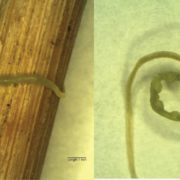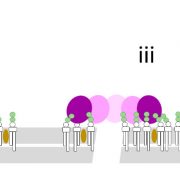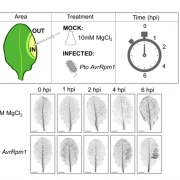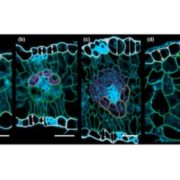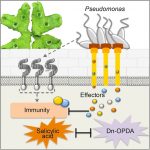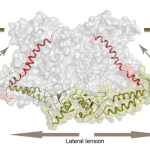Conserved biochemical defenses underpin host responses to oomycete infection in liverwort (Curr Biol)
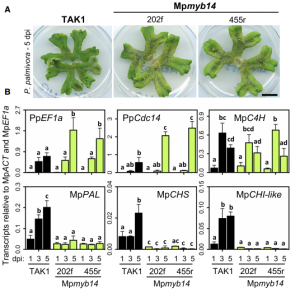 Marchantia polymorpha is an emerging model for plant molecular biology and has contributed to studies on development and plant-microbe interactions. Here, using RNA-seq and proteomics, Carella et al. present a detailed time-course analysis of Marchantia molecular responses to pathogen infection triggered by the oomycete Phytophtora palmitovora. By comparing Marchantia to tobacco responses, the authors show that many features of the molecular defense responses are conserved across land plants. Among them, genes encoding Pathogenesis-related (PR) proteins, phenylpropanoid biosynthesis enzymes, and transcription factors are induced after infection. As part of the response, anthocyanin-like compounds are synthesized and accumulated around Marchantia air chambers during infection. Altering expression of MpMyb14, a transcription factor that it is induced by pathogenesis and regulates flavonoid biosynthesis, alters susceptibity or resistance to P. palmitovora, demonstrating that flavonoid biosynthesis is an ancient and conserved defense mechanism and works in Marchantia similarly to angiosperms. This paper, along with that of Gimenez-Ibanez et al., establish Marchantia-microbe interaction systems that will serve as powerful tools to dissect plant defense mechanisms. (Summary by Facundo Romani) Curr. Biol. 10.1016/j.cub.2019.05.078.
Marchantia polymorpha is an emerging model for plant molecular biology and has contributed to studies on development and plant-microbe interactions. Here, using RNA-seq and proteomics, Carella et al. present a detailed time-course analysis of Marchantia molecular responses to pathogen infection triggered by the oomycete Phytophtora palmitovora. By comparing Marchantia to tobacco responses, the authors show that many features of the molecular defense responses are conserved across land plants. Among them, genes encoding Pathogenesis-related (PR) proteins, phenylpropanoid biosynthesis enzymes, and transcription factors are induced after infection. As part of the response, anthocyanin-like compounds are synthesized and accumulated around Marchantia air chambers during infection. Altering expression of MpMyb14, a transcription factor that it is induced by pathogenesis and regulates flavonoid biosynthesis, alters susceptibity or resistance to P. palmitovora, demonstrating that flavonoid biosynthesis is an ancient and conserved defense mechanism and works in Marchantia similarly to angiosperms. This paper, along with that of Gimenez-Ibanez et al., establish Marchantia-microbe interaction systems that will serve as powerful tools to dissect plant defense mechanisms. (Summary by Facundo Romani) Curr. Biol. 10.1016/j.cub.2019.05.078.


